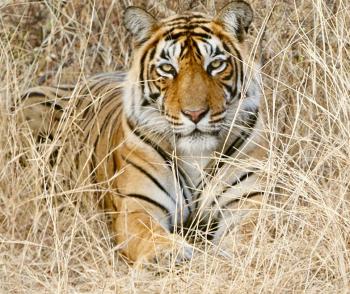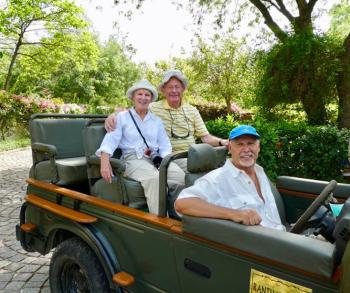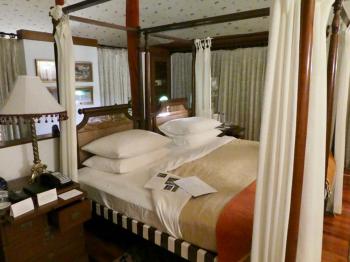Taking a 3-day tiger safari – a luxurious Indian adventure
This article appears on page 36 of the February 2019 issue.
On a recent Crystal Serenity cruise, I left the ship with six friends in Cochin (Kochi), India, for a 3-day excursion to Ranthambore National Park, one of several Indian tiger reserves. We would rejoin the ship in Mumbai (formerly Bombay).
Heading out
We started out early, meeting our tour rep on the dock at 6 a.m. We then drove to Cochin's airport, flew to Hyderabad and connected to another flight to Jaipur, where we were met at the airport and driven to the elegant Oberoi Rajvilas hotel, featuring 71 rooms on 32 acres of manicured grounds.
I have been lucky to have stayed in some gorgeous hotels, but none have been more beautiful or tastefully decorated than this one. I had a huge marble sunken tub in the bath, fine furnishings and all the amenities one might need. Oberoi is a first-class chain, and this hotel is indicative of their quality.
I was up early the next day to the screeching of the dozen peacocks that inhabit the beautiful grounds of the hotel. Treated to a magnificent breakfast buffet, my friends and I then got into a van for a 4-hour drive to the tiger reserve — and another Oberoi hotel, The Oberoi Vanyavilas, situated on 20 beautiful acres (and also with a muster of peacocks).
Because of its proximity to the national park and the tigers, the hotel's theme is safari-like. Guests stay in "tents" (there are only 25 on the grounds), but you'd never know it from the inside. My tent had a polished wooden floor, air-conditioning, a large claw-footed bathtub, a large marble shower, TV, Wi-Fi and every other amenity you could want.
The walls were solid, with large windows. The only thing tent-like about it was the large white-canvas roof. Otherwise, it was a large, elegant hotel room.
Searching for tigers
After a sumptuous lunch, we were off on our first game drive. Our group of seven was divided into two vehicles, each with its own driver and guide. The vehicle I was in found a tiger taking a nap about 100 feet from where our open-top safari jeep was able to park.
He was lying with his backside toward us, and we decided to wait for him to arise. We waited … and waited, from 4 to 6 p.m., in the 80-degree heat, but all he did was twitch a little, shake his leg a little and sleep a lot. We finally gave up and returned to the hotel.
We did see hundreds of sambar deer, langur monkeys, many peacocks and a wild boar while driving though the forest, but you can imagine how we felt when, upon returning to the hotel, we found other guests showing off their photographs of the tigers they had seen on their game drives at the same time we were striking out. Well, there was always the next day.
This national park covers about 400 square kilometers (154 square miles) and is home to around 60 tigers. The park is divided into 10 zones; we had been in zone 2. The next day, we were assigned to another zone, zone 3.
We left at 6 the next morning for our second game drive, and within an hour we discovered a female tiger lying in some tall, dry grass. We were able to photograph her head-on, but she did not want to move. (I should note that we, the travelers, did not discover the tiger; it was our guide, with his keen vision, who spotted her.)
But 30 minutes later, as we were driving elsewhere in the park, we found her coming down a low hill into a dry riverbed. She came right toward our vehicle and crossed the road 10 feet in front of us. Wow!
The rippling muscles under her coat gave a sense of the power of this creature. She was beautiful, and seeing her made our trip a great success.
About the park
The roads we took could hardly be called roads. They were, instead, wide paths scraped through the forest by bulldozers. And they were the most rocky roads I've ever seen … or felt!
Our vehicle was a 4-wheel-drive jeep, and if it had shocks, they had been worn out long ago by the rocky terrain. One member of our group of seven told me at lunch that he would not be going on our last game drive because he could not take the bouncing.
No one with a back or neck problem should ever take one of these game drives. There was not a smooth 10 seconds that we experienced while riding.
Over our 3-day excursion, we took a morning game drive each day, arising early enough to get coffee and rolls at 5:45 before meeting our guide and driver at the front of the hotel. The drive to the entrance of the park took about 20 minutes, then we would follow roads to the zone of the park to which our group had been assigned for that game drive. (Besides the previously mentioned animals seen on our drives, we also saw a mongoose and many antelopes.)
We would return from our morning game drive about 9:30, have a full breakfast and then be at leisure until lunch, which was followed by an afternoon game drive. During the break, some guests would go to the pool, others checked their email or edited their photos, and still others went to the hotel's spa for a massage to work out the aches from the bumpy rides.
Our afternoon game drive would end at 7 p.m. One day, guides who had conducted game drives earlier in the day reported that a mother tiger and three cubs had appeared at a certain water hole at about 1 p.m. that afternoon, and they thought the tigers might return for another drink at about 5, so our jeep headed for that water hole, and so did 12 other vehicles filled with expectant guests. It looked like a jeep convention! There must have been close to 100 people congregated around this large water hole, all waiting for mama tiger to show up.
We waited for an hour and 20 minutes, but no tigers. We finally had to return to the hotel.
Well, that's the nature of searching for tigers. There are no guarantees. Our guide, who had been working there for 18 years, told us that in a week's time, he might see a tiger on two days.
That evening the hotel prepared a lovely farewell dinner and surprised us by presenting each of us with a dessert plate with our name written in chocolate — a very nice gesture. I cannot say enough about the courtesy and professionalism of the staff at the two Oberoi hotels in which we stayed on this adventure.
Our 3-day excursion was put together by my agent at Tully Luxury Travel (Toronto, Canada; 855/265-0890, www.tullyluxurytravel.com) and was run locally by &Beyond, who did an excellent job.
As a single, I paid about $4,500, including airfare, hotel and all meals.
The excursion's end
The next day, we were driven back to Jaipur, where we caught a plane to Mumbai and rejoined the ship.
The drive from the Mumbai airport to the ship gave us a chance to see the dichotomy in India between the "haves" and the "have nots." Within sight of the sleek, modern airport terminal were hundreds of ramshackle dwellings inhabited by the poorest of the poor.
The caste system is still very much in place in India, and the poor really have it bad. As we drove along, we saw sleek new skyscrapers literally next door to hovels, where people were hanging out of the windows just to get some air in the stifling 85-degree heat (at 6 p.m.).
The streets were full of people, many just sitting on the curb or on chairs in front of their shacks — anything, I imagine, to get out of their tiny rooms.
You see a lot of things when you travel, many of them magnificent, but there's also the darker side. Remember to count your blessings.



